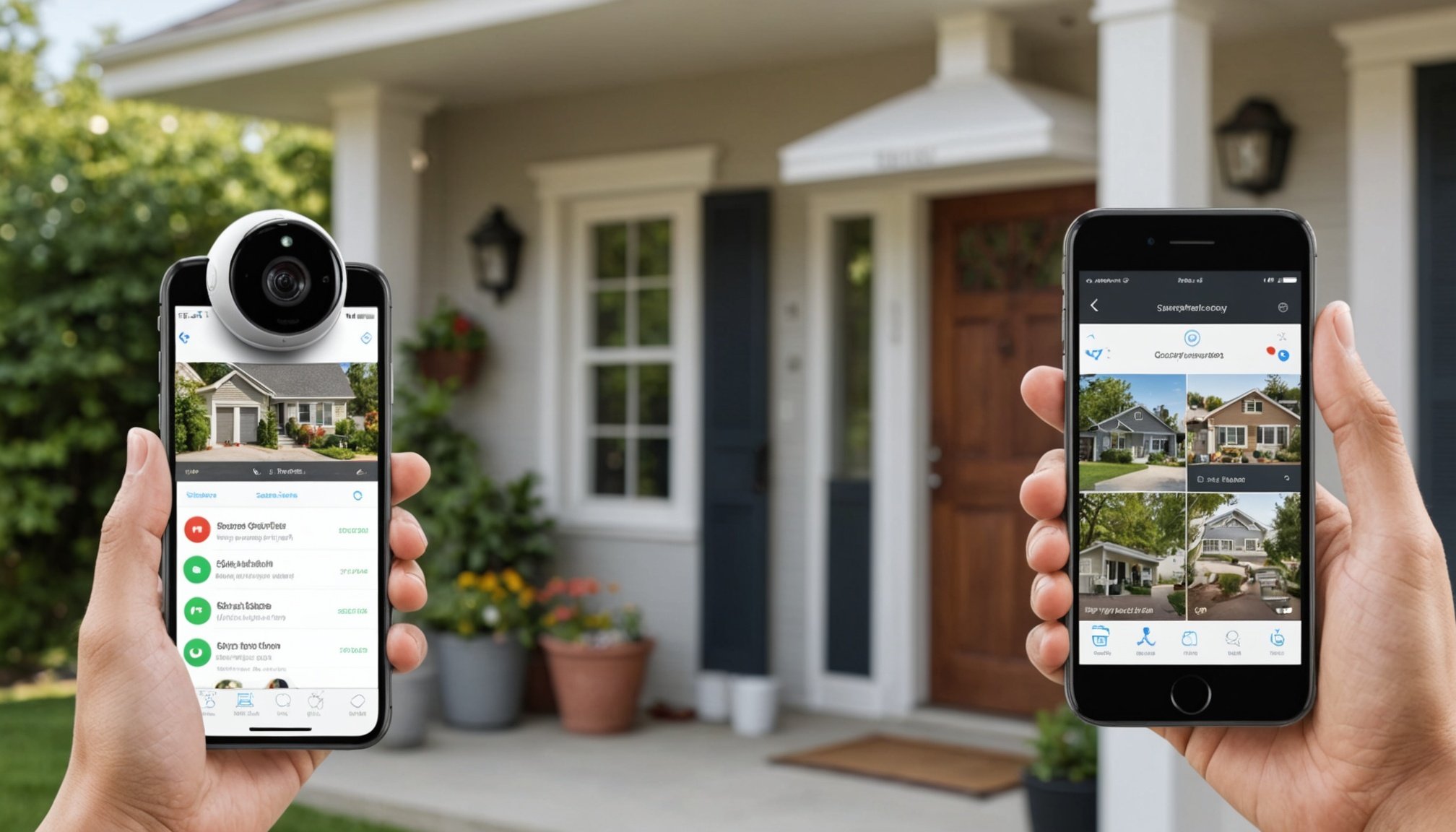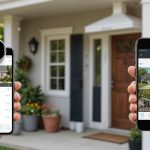Overview of Smartphone Notifications from Smart Home Security Cameras
Smart home security features have evolved to ensure users receive instant alerts, enhancing overall security. Timely smartphone notifications are critical for quick action, allowing homeowners to address threats like intrusions swiftly. With the advent of these notifications, user response times have significantly improved, providing a sense of security unlike before.
Smart home security cameras come equipped with features that specifically support this functionality. They detect unusual activities and instantly alert users through applications. Homeowners then receive immediate communication, allowing them to take essential actions even when away from home. This sense of connectivity reassures users of their home’s security status.
Also to see : Essential Apps for Effortless Control of Multi-Room Smart Home Audio Systems
These smart home systems necessitate the integration of a user-friendly configuration process, making setup uncomplicated. This easiness encourages user engagement, offering streamlined methods to receive real-time alerts without frequent technical interference. Such integration is pivotal, ensuring homeowners are always a step ahead of potential security breaches.
For those seeking enhanced home security, understanding the flow of smartphone notifications and real-time alerts is essential. By leveraging these features, individuals can maintain peace of mind, knowing they’re proactively safeguarding their homes. This progressive approach ensures a heightened standard of security and interaction, embodying technological advancement.
Also to see : Reinforce Your Home Security: The Ultimate Smartphone Guide to Enhancing Safety with Smart Lighting Innovations
Setting Up Smartphone Notifications
Establishing mobile alerts for your smart camera is a crucial step towards enhancing your home security. The setup process should be straightforward and user-friendly, ensuring you receive timely notifications. Correctly configuring notifications not only aids in immediate alertness but fosters increased user engagement with your security system.
Step-by-Step Guide to Enabling Notifications
Activating notifications typically involves installing a relevant app on your smartphone. Follow the configuration guidelines provided by the camera manufacturer. Navigate through the app settings to enable notifications and customize alert preferences according to sensitivities and schedules.
Common Features Across Different Devices
Most devices offer features such as motion detection and scheduled alerts. These smart home security features improve security by ensuring users are updated in real-time. Adjusting these settings allows users to optimize their mobile alerts for their unique needs.
Connecting Your Smart Camera to Mobile Devices
To connect your smart camera to your smartphone, begin by ensuring both devices are on the same Wi-Fi network. Use the camera’s app to pair it with your mobile device, following the manufacturer’s detailed instructions. Look for recommended apps to ease the setup process, ensuring reliable configuration and operational efficiency.
Benefits of Instant Smartphone Alerts
Smart homeowners crave security that keeps up with their dynamic lifestyles. Instant smartphone alerts are pivotal in achieving this, providing timely updates when abnormalities arise. This capability significantly enhances the safety of households, boosting user engagement with security systems.
With such alerts, homeowners can swiftly counteract potential security breaches. Receiving real-time updates ensures that even when individuals are away, the immediate detection of issues facilitates quicker responses. This proactive approach means that users do not just react to problems but remain one step ahead, safeguarding their property.
The peace of mind these alerts offer is invaluable. Being informed enables homeowners to rest easy, knowing their living spaces are actively monitored. The constant communication between the system and the user helps maintain an attentive and secure environment.
Furthermore, increased interaction with these systems enriches the experience of the user. By frequently engaging with notifications, users develop a deeper understanding of their security technology. This familiarity fosters trust in the system’s capabilities and reinforces its role within the modern home. As technology advances, the role of instant smartphone alerts will undoubtedly grow in significance, offering ever-enhanced protection.
Comparing Smart Home Security Systems
In the realm of smart home security systems, choosing the right system can be daunting given the array of options available. Conducting a thorough system comparison helps you understand key differences and identify which features align with your needs.
Leading Smart Home Security Brands
Popular brands like Ring, Nest, and Arlo dominate the market. These companies offer systems with unique functionalities such as enhanced smartphone notifications and user-friendly interfaces. Understanding what each brand offers is a crucial step in making an informed decision.
Feature Highlights of Each System
Each system provides standout features, including instant alerts and integration capabilities. Features like motion detection, night vision, and two-way audio vary across platforms but are common selling points. Analysing these features ensures you choose a system that offers optimal security and convenience.
Price Point Considerations
When comparing systems, consider both initial costs and potential service fees. While Ring may offer budget-friendly options, Nest often provides more premium features but at a higher price point. Balancing cost with the value proposition is vital for making a choice that meets both your financial and security needs.
Troubleshooting Notification Issues
Experiencing troubles with your smartphone notifications can be frustrating, but understanding common issues and solutions is the first step toward resolution.
Addressing Common Notification Problems
Many users encounter issues such as delayed or missing instant alerts. Often, these hiccups stem from incorrect configuration settings or connectivity problems. Ensuring that your device’s settings allow notifications is essential – sometimes they need to be manually enabled in the phone’s settings or the app itself. In cases of delayed notifications, it may be due to network lags or app server inconsistencies.
Tips for Improving Connectivity
Stable connectivity is vital for maintaining reliable mobile alerts. If you frequently miss notifications, check that your smart camera and smartphone are on a stable, shared Wi-Fi network. Additionally, ensuring your device’s firmware and the app are up to date can often resolve persistent connectivity issues. If network disruptions persist, consider using a stronger or closer Wi-Fi signal for your security system.
When to Seek Professional Help
If common troubleshooting steps don’t resolve the issue, it might be time to consult professional assistance. Persistent smart home security problems could indicate deeper hardware malfunctions or software bugs that require expert solutions. Recognising when to seek help can save time and ensure system functionality.
User Testimonials and Experiences
Exploring user reviews and real-life experiences provides valuable insights into the effectiveness and challenges of smart home notification systems. Many users report positive outcomes, highlighting increased security and peace of mind. These testimonials frequently note how instant alerts enable them to respond swiftly to potential threats, boosting confidence in their home security setup.
Feedback often praises the ease of setup and customization of notifications, with users enjoying the seamless integration of smartphone notifications. They appreciate how this connectivity allows for proactive actions against suspicious activities, making security more engaging and reliable.
Nonetheless, there are common concerns, particularly around connectivity issues. Some users experience delays or failures in receiving alerts, often attributing this to poor Wi-Fi connections or outdated app installations. Such experiences underscore the importance of maintaining a stable network and keeping devices updated to ensure consistent performance.
Case studies further demonstrate the effectiveness of instant alerts in real-world scenarios. Homeowners have thwarted potential burglaries by receiving timely warnings, showcasing the tangible benefits these systems offer. These user narratives serve as both endorsements and instructional anecdotes, informing potential adopters of the advantages and occasional limitations inherent in smart home notifications.
Privacy and Security Considerations
In the realm of smart home security, understanding privacy concerns is crucial. As these systems collect data to provide instant alerts, ensuring data security must be a priority to maintain user trust. Often overlooked, data security involves safeguarding the information collected by cameras, ensuring it isn’t compromised or mishandled.
Implementing recommended practices can greatly enhance the security of your data. Start by choosing systems with strong encryption protocols, which protect data as it’s transmitted between devices. Regularly updating firmware can prevent vulnerabilities from being exploited. Additionally, setting strong, unique passwords for each device ensures that unauthorized access is minimized.
Balancing functionality and privacy requires transparency from smart home devices. Users should be informed about what data is collected and how it is used. Smart security systems with clear privacy policies help users make informed choices. Furthermore, opting for devices that allow customization of data-sharing settings can increase comfort, as users have more control over their personal information.
In the evolving landscape of smart home technology, prioritizing data privacy fosters trust and maximizes the benefits of security systems without compromising user security. This equilibrium ensures a sustainable relationship with our digital homes.






